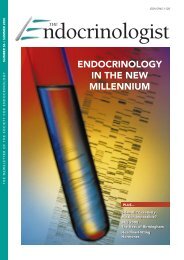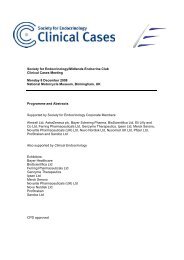Standards for undergraduate medical education - Society for ...
Standards for undergraduate medical education - Society for ...
Standards for undergraduate medical education - Society for ...
You also want an ePaper? Increase the reach of your titles
YUMPU automatically turns print PDFs into web optimized ePapers that Google loves.
Hot Topics<br />
Igfbp1 KO: prostate cancer and metabolism<br />
Prostate cancer is the most common cancer in men.<br />
Increased IGFBP1 levels may protect against its development.<br />
Gray et al. crossed and interbred c-Myc transgenic mice (WT)<br />
with Igfbp1 knockout (KO) mice to investigate whether<br />
deleting Igfbp1 accelerates development of prostate cancer.<br />
No difference in the incidence of the disease or in total IGF1<br />
levels was seen between WT and KO mice.<br />
Read the full article in Journal of Endocrinology 211 299–306<br />
Testosterone prevents prostate inflammation<br />
in metabolic syndrome<br />
High-fat diet (HFD)-induced metabolic syndrome is<br />
associated with hypogonadism and prostate inflammation.<br />
Vignozzi and colleagues examined the effects of<br />
testosterone supplementation using male rabbits fed an<br />
HFD. Testosterone led to increased expression of prostate<br />
proinflammatory marker mRNA and amelioration of all<br />
HFD-induced features, including hypoxia and fibrosis. This<br />
may be in<strong>for</strong>mative in preventing benign prostate<br />
hyperplasia and lower urinary tract symptoms.<br />
Read the full article in Journal of Endocrinology 212 71–84<br />
Regulation of glucose homeostasis<br />
Somatostatin is important in regulating neurotransmission<br />
and secretion. Octreotide, a somatostatin analogue, is used<br />
to treat acromegaly and neuroendocrine tumours. Schmid<br />
& Brueggen investigated another analogue, pasireotide,<br />
which has therapeutic potential in Cushing’s disease. The<br />
two analogues inhibited insulin levels in rats to a similar<br />
degree, but only pasireotide led to transient<br />
hyperglycaemia. This increases our knowledge of effects of<br />
somatostatin analogues in glucose homeostasis.<br />
Read the full article in Journal of Endocrinology 212 49–60<br />
JOURNAL OF<br />
MOLECULAR ENDOCRINOLOGY<br />
TNFRSF11B and low BMD<br />
Osteoprotegerin (OPG) negatively regulates<br />
osteoclastogenesis. Polymorphisms of TNFRSF11B, the<br />
OPG gene, are linked to osteoporosis. Vidal et al.<br />
investigated two polymorphisms with strong linkage<br />
disequilibrium to each other, C950T and rs4876869. The C<br />
allele of rs4876869 affected pre-mRNA splicing, giving two<br />
transcripts, one lacking exon 3, leading to a less effective<br />
OPG iso<strong>for</strong>m. The T allele of C950T increased low BMD risk<br />
in postmenopausal women by decreasing OPG expression.<br />
Haplotypes C-G-T and C-C-C had protective roles.<br />
Read the full article in Journal of Molecular Endocrinology 47<br />
327–333<br />
miRNAs in follicular thyroid tumours<br />
MicroRNAs (miRNAs) are abnormally expressed or lost in<br />
several cancers, so Rossing and colleagues investigated<br />
their use in tumour classification. They found differentially<br />
expressed miRNAs in follicular thyroid carcinoma and<br />
adenoma. Transcript miR-199b-5p (lost in the carcinoma)<br />
decreased cell doubling time by ~23%, indicating a<br />
possible role in follicular carcinoma growth. miRNA analysis<br />
may aid diagnosis of follicular thyroid cancer.<br />
Read the full article in Journal of Molecular Endocrinology 48<br />
11–23<br />
Proliferation response to short-term endocrine<br />
therapy<br />
Letrozole is an aromatase inhibitor used in ER-positive<br />
breast cancer. Bedard and colleagues used the gene<br />
expression grade index (GGI) to determine clinical<br />
response to neoadjuvant letrozole. Women with low<br />
genomic grade tumours were more likely to respond to 3<br />
months of letrozole. GGI was a useful predictive biomarker<br />
of response to neoadjuvant anti-oestrogen therapy in postmenopausal<br />
patients with ER-positive breast cancer.<br />
Read the full article in Endocrine-Related Cancer 18 721–730<br />
Oxidative stress and thyroid cancer<br />
High production of reactive oxygen species can cause<br />
oxidative stress, which is involved in cancer<br />
pathophysiology. Wang and colleagues investigated the<br />
relationship between markers of oxidative stress and serum<br />
thyroid profiles in thyroid cancer. The ratio of total oxidant<br />
status to total antioxidant status was significantly higher in<br />
patients than in controls. This was the best marker to<br />
distinguish cancer patients from other thyroid patients.<br />
Read the full article in Endocrine-Related Cancer 18 773–782<br />
Clinical Endocrinology<br />
Adipogenic capacity and metabolic syndrome<br />
Understanding regulation of abdominal fat mass is<br />
important in treating metabolic syndrome. In their<br />
commentary, Lansdown et al. discuss research by Park and<br />
colleagues, which suggests that enhanced adipogenic<br />
capacity of subcutaneous fat depots may protect against the<br />
syndrome. They discuss ‘adipose tissue expandability’: the<br />
idea that individuals have limited adipose tissue expansion,<br />
after which lipid is deposited in non-adipose organs, leading<br />
to insulin resistance and other metabolic problems. The<br />
study supports the concept that subcutaneous adipogenic<br />
potential may help determine metabolic risk.<br />
Read the full article in Clinical Endocrinology 76 59–66<br />
Commentary Clinical Endocrinology 76 19–20<br />
Lipoprotein alterations and GH in obesity<br />
GH-deficient (GHD) subjects have increased cardiovascular<br />
morbidity and mortality due to premature atherosclerosis.<br />
This has been linked to pro-atherogenic lipoprotein<br />
alterations. Rizzo & Mikhailidis’s commentary considers<br />
findings by Makimura et al. that smaller LDL and HDL<br />
particles are increased in obese GHD subjects, in relation to<br />
obese subjects with normal GH or non-obese subjects. It is<br />
likely that obesity results in GHD, and reduced GH further<br />
contributes to abnormal lipoprotein particle size in obesity.<br />
Read the full article in Clinical Endocrinology 76 220–227<br />
Commentary Clinical Endocrinology 76 177–178<br />
Free access to Clinical Endocrinology<br />
Since 2010, all members of the <strong>Society</strong> <strong>for</strong><br />
Endocrinology have had free access to the most up-todate<br />
research published online in Journal of<br />
Endocrinology, Journal of Molecular Endocrinology and<br />
Endocrine-Related Cancer, via the BioSciAlliance portal.<br />
Free access has now also been extended to Clinical<br />
Endocrinology. Members are reminded that free online<br />
access to the journals is <strong>for</strong> your personal use only. If<br />
institutional access is required, please contact Ceredig<br />
Williams (ceredig.williams@endocrinology.org).<br />
HOT TOPICS<br />
<strong>Society</strong> members<br />
get free access to<br />
the current content<br />
of Journal of<br />
Endocrinology,<br />
Journal of<br />
Molecular<br />
Endocrinology,<br />
Endocrine-<br />
Related Cancer<br />
and Clinical<br />
Endocrinology via<br />
www.bioscialliance.org<br />
T H E E N D O C R I N O L O G I S T • I S S U E 1 0 3 • S P R I N G 2 0 1 2<br />
23



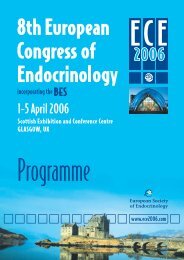
![The Endocrinologist | Issue 99 [PDF] - Society for Endocrinology](https://img.yumpu.com/48213777/1/184x260/the-endocrinologist-issue-99-pdf-society-for-endocrinology.jpg?quality=85)

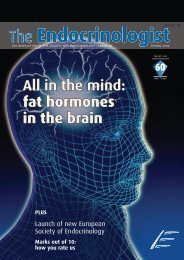
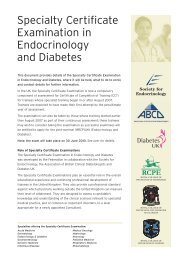

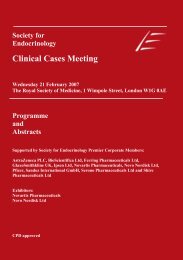

![The Endocrinologist | Issue 97 [PDF] - Society for Endocrinology](https://img.yumpu.com/40840065/1/184x260/the-endocrinologist-issue-97-pdf-society-for-endocrinology.jpg?quality=85)

